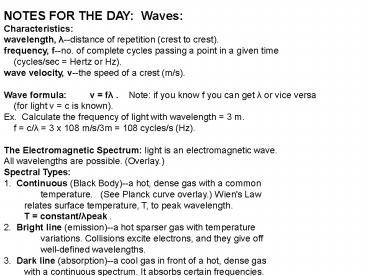NOTES FOR THE DAY: Waves: - PowerPoint PPT Presentation
1 / 20
Title:
NOTES FOR THE DAY: Waves:
Description:
frequency, f--no. of complete cycles passing a point in a given time (cycles/sec ... Collisions excite electrons, and they give off well-defined wavelengths. ... – PowerPoint PPT presentation
Number of Views:37
Avg rating:3.0/5.0
Title: NOTES FOR THE DAY: Waves:
1
NOTES FOR THE DAY Waves Characteristics wavele
ngth, ?--distance of repetition (crest to
crest). frequency, f--no. of complete cycles
passing a point in a given time (cycles/sec
Hertz or Hz). wave velocity, v--the speed of a
crest (m/s). Wave formula v f? .
Note if you know f you can get ? or vice versa
(for light v c is known). Ex. Calculate the
frequency of light with wavelength 3 m. f
c/? 3 x 108 m/s/3m 108 cycles/s (Hz). The
Electromagnetic Spectrum light is an
electromagnetic wave. All wavelengths are
possible. (Overlay.) Spectral Types 1.
Continuous (Black Body)--a hot, dense gas with a
common temperature. (See Planck curve
overlay.) Wien's Law relates surface
temperature, T, to peak wavelength. T
constant/?peak . 2. Bright line (emission)--a
hot sparser gas with temperature variations.
Collisions excite electrons, and they give
off well-defined wavelengths. 3. Dark line
(absorption)--a cool gas in front of a hot, dense
gas with a continuous spectrum. It
absorbs certain frequencies.
2
Light As Messenger Waves Characteristics wavele
ngth, ?--distance for repetition, crest to crest.
wave velocity, v--the speed of a crest (in m/s).
3
frequency, f--no. of complete cycles passing a
point in a given time (cycles/sec Hertz or Hz).
4
Wave formula v f? . Note if you
know f you can get ? or vice versa (for
light v c is known). Ex. Calculate the
frequency of light with wavelength 3 m. f
c/? 3 x 108 m/s/3m 108 cycles/s (Hz). FM
radio frequency 100 megahertz.
5
(No Transcript)
6
- Spectral Types
- Continuous (Black Body) spectrum
- --a hot, dense gas with a common temperature.
Planck curve.
7
Wien's Law for continuous spectrum
relates surface temperature, T, to peak
wavelength. T constant/?peak .
8
2. Bright line (emission) spectrum--a hot
sparser gas with temperature variations.
Collisions excite electrons, and they give off
well-defined wavelengths.
9
3. Dark line (absorption) spectrum--a cool gas
in front of a hot, dense gas with a continuous
spectrum. It absorbs certain frequencies. Kirchoff
s Laws of Spectral Formation
10
NOTES FOR THE DAY Why are there spectral
lines? Note the spectrum of the sun in the
overlay. How did the dark lines get there? Atoms
are made up of protons and neutrons in the
nucleus and electrons 'in orbit' about
them. Example--The Hydrogen Atom Quantum
Theory says electrons have orbits of certain
energies this is like different sized stair
steps. They give off light when they fall to a
lower lever (emission) and absorb it when they
encounter just the right energy light
(absorption). See diagram of H atom energy
levels. Elements are identified in the periodic
table and have their individual 'thumbprints' of
spectral lines. The number of the element the
atomic number protons electrons in a
neutral atom. Spectroscopy--study of
spectra. Spectroscope (spectrometer)--device to
study light spectra. Planck's Law--the energy of
a photon, or light quantum (particle or bundle),
is proportional to its frequency E hf.
11
Why are there spectral lines? Note the spectrum
of the sun in the picture.
12
Atoms are made up of protons and neutrons in the
nucleus and electrons 'in orbit' about them.
13
Quantum Theory says electrons have orbits of
certain energies this is like different sized
stair steps.
Example the Hydrogen atom
n is the principal quantum number
14
(No Transcript)
15
Balmer lines are the visible lines of
Hydrogen and have n 2 as their lower
level. Lyman lines are UV and have n 1 as the
lower level in the transition.
16
Elements are identified in the periodic table
and have their individual 'thumbprints' of
spectral lines. The number of the element the
atomic number protons electrons in a
neutral atom.
17
Spectroscopy--study of spectra. Spectroscope
(spectrometer)--device to study light spectra.
18
Planck's Law (1900)--the energy of a photon, or
light quantum (particle or bundle), is
proportional to its frequency
E hf.
19
The Doppler Effect Light lowers in frequency
when source has relative velocity away from
observer (red shift), raises in frequency when
approaching (blue shift). Relative velocity can
be obtained from the frequency shift.
20
(No Transcript)































